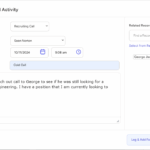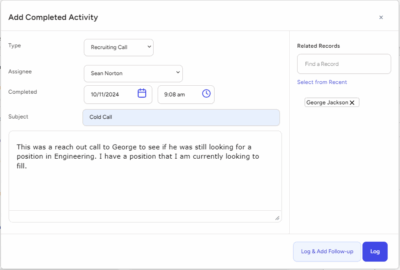Agency recruiters and search consultants are constantly seeking innovative ways to enhance their effectiveness and expand their reach. One approach that has gained significant traction is leveraging a split placement network through team recruitment.
This collaborative model, which involves two or more recruiters sharing the responsibility and rewards of placing candidates, can offer a powerful synergy by combining resources, expertise, and networks to achieve superior placement outcomes.
This blog post aims to provide an in-depth understanding of how team recruitment works within such a network, the benefits it offers, and strategies for success.
Understanding Split Placement Networks
A split placement network is a collaborative platform where recruiters and search consultants from different agencies work together to fill job openings. Typically, one recruiter (the job order recruiter or job recruiter) provides the job order from the client, while another recruiter (the candidate recruiter) presents candidates suitable for the role. The placement fee is then split between the recruiters based on a pre-agreed percentage.
What Makes Split Placement Networks Unique?
Split placement networks capitalize on the strengths and networks of multiple recruiters, allowing for a more extensive reach and better candidate matches. The collaboration between different recruiters brings a diverse set of skills, knowledge, and contacts, which enhances the overall recruitment process.
How Team Recruitment Functions in a Split Placement Network
Initiation and Collaboration
The process begins with the identification of a job order by the job recruiter. This recruiter posts the job order on the split placement network platform, outlining the job requirements, qualifications, and other pertinent details. Candidate recruiters, who have access to the platform, review the job orders and identify opportunities where their candidates might be a fit.
Key Steps in Initiation and Collaboration:
- Detailed Job Order Posting: The job recruiter must ensure that the job order is detailed and comprehensive, covering all necessary aspects such as job responsibilities, qualifications, company culture, and specific client preferences.
- Active Candidate Search: Candidate recruiters actively search their databases and networks for potential matches. They leverage their expertise and understanding of the job requirements to identify the best candidates.
- Initial Communication: The initial phase also involves open communication between the job recruiter and the candidate recruiter to clarify any questions and ensure alignment on the job requirements and expectations.
Building the Team
Effective team recruitment involves selecting the right partners within the network. Job recruiters look for candidate recruiters who have a proven track record of presenting high-quality candidates in the relevant industry or job function. Conversely, candidate recruiters seek job recruiters who consistently work with reputable clients and provide detailed job orders.
Strategies for Building a Successful Team:
- Evaluate Compatibility: Assess potential partners for compatibility in terms of work ethics, communication styles, and commitment to quality. Compatibility ensures smooth collaboration and effective teamwork.
- Leverage Network Tools: Utilize the tools and features provided by the split placement network platform. These may include candidate tracking systems, communication tools, and performance analytics, all of which can facilitate effective collaboration.
- Establish Trust: Trust is fundamental in split placements. Building trust requires transparency, reliability, and a clear understanding of mutual goals. Regular communication and accountability are key to maintaining trust.
Communication and Coordination
Once a team is formed, clear and consistent communication is crucial. The job recruiter needs to provide comprehensive information about the client’s needs, company culture, and any specific preferences. The candidate recruiter must share detailed profiles of potential candidates, including their resumes, cover letters, and any additional relevant information. Regular updates and feedback exchanges are essential to ensure that both parties are aligned and working efficiently towards the common goal.
Best Practices for Communication and Coordination:
- Regular Updates: Schedule regular check-ins to discuss the progress of candidate searches, feedback from clients, and any adjustments needed. These updates help maintain momentum and ensure that both parties are on the same page.
- Effective Use of Technology: Leverage video calls, instant messaging, and project management software to facilitate seamless interaction. These tools help bridge the gap between different teams and ensure effective collaboration.
- Feedback Mechanisms: Establish clear feedback mechanisms to provide timely and constructive feedback. This helps in refining the candidate search and ensuring that only the most suitable candidates are presented to the client.
Candidate Submission and Evaluation
The candidate recruiter submits potential candidates to the job recruiter, who then evaluates their suitability for the role. This evaluation includes reviewing resumes, conducting preliminary interviews, and assessing the candidates’ fit with the client’s requirements. The job recruiter provides feedback to the candidate recruiter, who may need to adjust their search criteria or provide additional candidates.
Steps for Effective Candidate Submission and Evaluation:
- Detailed Candidate Profiles: Ensure that candidate profiles are detailed and include all relevant information such as work experience, skills, education, and references. This provides a comprehensive view of the candidate’s suitability.
- Structured Evaluation Process: Implement a structured evaluation process that includes resume reviews, initial interviews, and skills assessments. This ensures consistency and thoroughness in evaluating candidates.
- Timely Feedback: Provide timely feedback to the candidate recruiter, highlighting areas for improvement or additional information needed. This iterative process helps in refining the candidate pool and improving the chances of a successful placement.
Client Presentation and Interviews
Once the job recruiter identifies suitable candidates, they present them to the client. The job recruiter coordinates the interview process, which may involve scheduling interviews, preparing candidates, and gathering feedback from the client. Throughout this process, the job recruiter keeps the candidate recruiter informed, ensuring transparency and collaboration.
Effective Client Presentation and Interview Coordination:
- Thorough Preparation: Prepare candidates thoroughly by providing them with detailed information about the job, the company, and the interview process. This preparation increases their confidence and performance during interviews.
- Efficient Scheduling: Coordinate interview schedules efficiently, taking into consideration the availability of both candidates and clients. This helps in minimizing delays and ensuring a smooth interview process.
- Gathering Feedback: Collect detailed feedback from the client after each interview. This feedback is crucial for refining the candidate search and making any necessary adjustments.
Offer and Placement
If the client decides to extend an offer to one of the candidates, the job recruiter manages the offer process, including salary negotiations, offer acceptance, and onboarding. Once the candidate accepts the offer and starts the job, the placement is considered successful, and the placement fee is split between the job recruiter and the candidate recruiter as per their agreement.
Managing the Offer and Placement Process:
- Negotiation: Facilitate the negotiation process to ensure that both the client’s and candidate’s expectations are met. This involves discussing salary, benefits, and other terms of employment.
- Offer Acceptance: Once the offer is accepted, ensure a smooth transition by providing the candidate with all necessary information and support.
- Onboarding: Assist with the onboarding process to help the candidate integrate smoothly into their new role. A positive onboarding experience can significantly improve the candidate’s engagement and retention.
Benefits of Team Recruitment in a Split Placement Network
Access to a Broader Talent Pool
By collaborating with other recruiters, both job recruiters and candidate recruiters can access a wider pool of candidates and job orders. This expanded reach increases the likelihood of finding the perfect match for a client’s needs.
Expanding Your Talent Pool:
- Leveraging Collective Networks: Access the collective networks of multiple recruiters, which significantly broadens the range of candidates available.
- Tapping into Niche Markets: Partnering with recruiters who specialize in different industries or job functions allows you to tap into niche markets and find highly qualified candidates.
- Improving Match Quality: With a broader talent pool, recruiters can find candidates who are not only qualified but also a great cultural fit for the client’s organization.
Enhanced Specialization
Recruiters can focus on their areas of expertise. Job recruiters concentrate on client relationships and understanding job requirements, while candidate recruiters specialize in sourcing and evaluating candidates. This division of labor leads to higher quality placements.
Enhancing Specialization:
- Focusing on Strengths: Allow recruiters to focus on their strengths, whether it’s client relationship management or candidate sourcing. This specialization leads to more efficient and effective recruitment processes.
- Improving Quality: Specialized recruiters bring in-depth knowledge and expertise, which improves the quality of placements and enhances client satisfaction.
- Streamlining Processes: Division of labor streamlines processes, reduces redundancy, and ensures that each aspect of recruitment is handled by experts.
Increased Placement Speed
With multiple recruiters working together, the time required to fill a position is significantly reduced. The combined efforts and shared resources lead to quicker candidate submissions and faster placements, benefiting both clients and candidates.
Accelerating Placement Speed:
- Efficient Sourcing: Collaborative sourcing speeds up the identification of suitable candidates.
- Quick Evaluations: Multiple recruiters working together can quickly evaluate and shortlist candidates, reducing time-to-fill.
- Rapid Feedback: Timely feedback and communication ensure that candidates move through the recruitment pipeline swiftly.
Shared Risk and Reward
In a split placement network, the financial risk and reward are shared between the recruiters. This collaborative approach reduces the pressure on individual recruiters and promotes a supportive environment where success is mutually beneficial.
Sharing Risk and Reward:
- Balanced Financial Risk: Sharing the financial risk and reward reduces the burden on individual recruiters and fosters a collaborative environment.
- Encouraging Collaboration: The shared reward model encourages collaboration and mutual support, leading to more successful placements.
- Building Partnerships: This collaborative approach helps build strong, long-term partnerships within the network.
Network Expansion and Relationship Building
Participating in a split placement network allows recruiters to build strong professional relationships with other recruiters. These connections can lead to future collaborations, knowledge sharing, and a more robust professional network.
Expanding Your Network:
- Building Strong Relationships: Collaborate with other recruiters to build strong, professional relationships.
- Future Collaborations: These relationships can lead to future collaborations and new business opportunities.
- Knowledge Sharing: Engage in knowledge sharing and best practices to enhance your recruitment strategies.
Strategies for Success in Team Recruitment
Selecting the Right Partners
Choosing the right partners is crucial for successful team recruitment. Look for recruiters with complementary skills, industry knowledge, and a reputation for professionalism. Building trust and establishing clear expectations from the outset can prevent misunderstandings and ensure a smooth collaboration.
Selecting the Right Partners:
- Complementary Skills: Partner with recruiters who have complementary skills and expertise.
- Industry Knowledge: Choose partners with in-depth industry knowledge and experience.
- Building Trust: Establish trust and clear expectations from the outset to ensure smooth collaboration.
Effective Communication
Clear and consistent communication is the cornerstone of a successful split placement. Regularly update your partner on progress, share feedback promptly, and address any concerns or issues as they arise. Utilize communication tools such as video calls, instant messaging, and project management software to facilitate seamless interaction.
Enhancing Communication:
- Regular Updates: Schedule regular updates to discuss progress and address any concerns.
- Using Technology: Utilize communication tools to facilitate seamless interaction and collaboration.
- Feedback Mechanisms: Establish clear feedback mechanisms to provide timely and constructive feedback.
Setting Clear Agreements
Before starting a collaboration, outline the terms of the split placement, including the percentage split of the placement fee, the responsibilities of each party, and the process for resolving disputes. Having a written agreement in place helps prevent conflicts and ensures both parties are on the same page.
Setting Clear Agreements:
- Percentage Split: Outline the percentage split of the placement fee in the agreement.
- Responsibilities: Clearly define the responsibilities of each party.
- Dispute Resolution: Include a process for resolving disputes to prevent conflicts.
Leveraging Technology
Utilize technology to streamline the recruitment process. Many split placement networks offer platforms with features such as job order management, candidate tracking, and communication tools. Leveraging these technologies can enhance efficiency and improve the overall experience for both recruiters and clients.
Utilizing Technology:
- Job Order Management: Use platforms with job order management features to streamline the recruitment process.
- Candidate Tracking: Implement candidate tracking tools to monitor progress and ensure timely follow-ups.
- Communication Tools: Leverage communication tools to facilitate seamless interaction and collaboration.
Continuous Learning and Adaptation
The recruitment landscape is constantly evolving, and staying ahead requires continuous learning and adaptation. Keep abreast of industry trends, new technologies, and best practices. Participate in webinars, attend industry conferences, and engage in professional development to enhance your skills and stay competitive.
Continuous Learning:
- Industry Trends: Stay updated on industry trends and emerging technologies.
- Professional Development: Engage in professional development opportunities to enhance your skills.
- Adapting Strategies: Continuously adapt your recruitment strategies to stay competitive.
Focusing on Quality
Quality should always take precedence over quantity. Rather than flooding your partner with numerous candidates, focus on presenting a smaller number of highly qualified candidates who closely match the job requirements. This approach not only improves the chances of a successful placement but also builds your reputation as a reliable and competent recruiter.
Prioritizing Quality:
- Highly Qualified Candidates: Focus on presenting highly qualified candidates who closely match the job requirements.
- Building Reputation: Prioritizing quality over quantity helps build your reputation as a reliable and competent recruiter.
- Improving Success Rates: This approach improves the chances of a successful placement and enhances client satisfaction.
Overcoming Challenges in Team Recruitment
Building Trust
Trust is fundamental to any successful collaboration. Building trust takes time and requires consistent, reliable performance. Be transparent with your partner, follow through on commitments, and demonstrate your expertise and professionalism.
Building Trust:
- Transparency: Maintain transparency with your partner to build trust.
- Consistent Performance: Ensure consistent, reliable performance to gain trust.
- Expertise and Professionalism: Demonstrate your expertise and professionalism to build credibility.
Managing Differences
Differences in working styles, communication preferences, and expectations can pose challenges. Address these differences proactively by discussing them openly and finding mutually agreeable solutions. Flexibility and adaptability are key to navigating these challenges successfully.
Managing Differences:
- Open Discussions: Address differences openly and find mutually agreeable solutions.
- Flexibility: Be flexible and adaptable to navigate challenges successfully.
- Understanding Expectations: Understand and align expectations to ensure smooth collaboration.
Ensuring Accountability
Accountability is essential in a split placement arrangement. Clearly define the responsibilities of each party and establish metrics for tracking progress. Regularly review performance and address any issues promptly to ensure that both parties are meeting their commitments.
Ensuring Accountability:
- Defining Responsibilities: Clearly define the responsibilities of each party in the agreement.
- Tracking Progress: Establish metrics for tracking progress and regularly review performance.
- Addressing Issues: Address any issues promptly to ensure commitments are met.
Maintaining Client Relationships
While collaboration is crucial, maintaining strong client relationships remains paramount. Ensure that the client’s needs and preferences are always prioritized. Keep the client informed about the progress of the search and involve them in key decisions to maintain their trust and satisfaction.
Maintaining Client Relationships:
- Prioritizing Needs: Always prioritize the client’s needs and preferences.
- Regular Updates: Keep the client informed about the progress of the search.
- Involving Clients: Involve clients in key decisions to maintain their trust and satisfaction.
Case Studies and Success Stories
Case Study 1: Leveraging Expertise in a Niche Industry
Agency A, a specialized IT recruitment firm, partnered with Agency B, which had a strong network of IT candidates but limited client connections. Agency A posted a high-demand job order for a cybersecurity expert on the split placement network. Agency B quickly identified a qualified candidate from their database and submitted the profile to Agency A. Within two weeks, the candidate was interviewed, offered the position, and accepted. Both agencies shared the placement fee, and the client was extremely satisfied with the speedy and effective placement.
Key Takeaways:
- Specialized Expertise: Leveraging specialized expertise can lead to quicker and more successful placements.
- Collaborative Approach: A collaborative approach can enhance efficiency and effectiveness.
- Client Satisfaction: Delivering speedy and effective placements enhances client satisfaction and strengthens relationships.
Case Study 2: Expanding Reach through Collaboration
A small boutique recruitment agency focused on finance roles, Agency C, joined a split placement network to expand its reach. By partnering with larger agencies, Agency C gained access to a broader range of job orders. They successfully placed several candidates in high-profile positions, significantly increasing their revenue and reputation in the industry. The larger agencies benefited from Agency C’s specialized candidate pool, resulting in a win-win situation.
Key Takeaways:
- Expanding Reach: Joining a split placement network can expand your reach and access to job orders.
- Increased Revenue: Successful placements can significantly increase revenue and reputation.
- Mutual Benefits: Collaboration leads to mutual benefits for all parties involved.
Team recruitment in a split placement network offers agency recruiters and search consultants a powerful model for achieving superior placement outcomes. By leveraging collaboration, specialization, and shared resources, recruiters can access a broader talent pool, enhance their efficiency, and increase their placement speed. The key to success lies in selecting the right partners, maintaining effective communication, setting clear agreements, leveraging technology, and focusing on quality.
While challenges such as building trust, managing differences, and ensuring accountability exist, they can be effectively addressed through proactive strategies and continuous learning. The benefits of participating in a split placement network, including shared risk and reward, network expansion, and enhanced specialization, far outweigh the challenges.
By embracing the principles and practices outlined in this guide, agency recruiters and search consultants can harness the full potential of team recruitment within a split placement network, ultimately delivering exceptional value to clients and candidates alike. With a well-implemented team recruitment strategy, recruiters can achieve faster, higher-quality placements and build stronger, more successful recruitment businesses.









